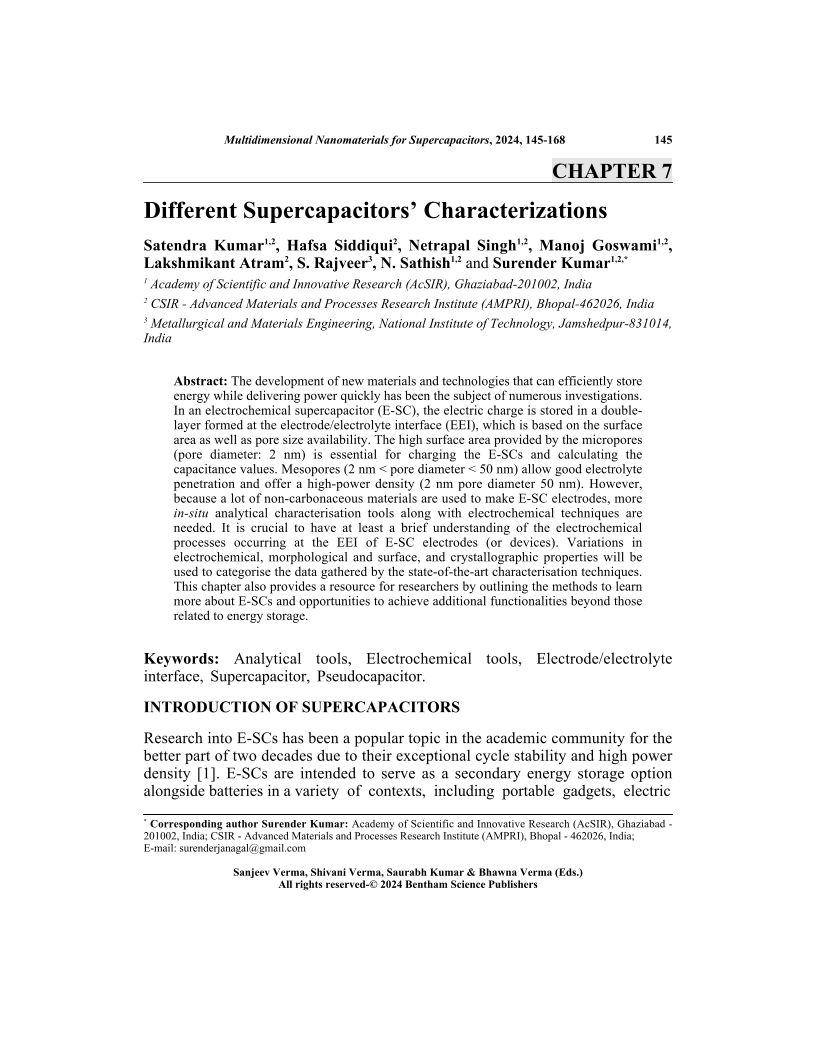Different Supercapacitors Characterizations

- Authors: Satendra Kumar1, Hafsa Siddiqui2, Netrapal Singh3, Manoj Goswami4, Lakshmikant Atram5, S. Rajveer6, N. Sathish7, Surender Kumar8
-
View Affiliations Hide Affiliations1 Academy of Scientific and Innovative Research (AcSIR), Ghaziabad 201002, India 2 CSIR - Advanced Materials and Processes Research Institute (AMPRI), Bhopal-462026, India 3 Academy of Scientific and Innovative Research (AcSIR), Ghaziabad-201002, India 4 Academy of Scientific and Innovative Research (AcSIR), Ghaziabad-201002, India 5 CSIR - Advanced Materials and Processes Research Institute (AMPRI), Bhopal-462026, India 6 Metallurgical and Materials Engineering, National Institute of Technology, Jamshedpur-831014, India 7 Academy of Scientific and Innovative Research (AcSIR), Ghaziabad-201002, India 8 Academy of Scientific and Innovative Research (AcSIR), Ghaziabad-201002, India
- Source: Multidimensional Nanomaterials for Supercapacitors: Next Generation Energy Storage , pp 145-168
- Publication Date: May 2024
- Language: English
The development of new materials and technologies that can efficiently store energy while delivering power quickly has been the subject of numerous investigations. In an electrochemical supercapacitor (E-SC), the electric charge is stored in a doublelayer formed at the electrode/electrolyte interface (EEI), which is based on the surface area as well as pore size availability. The high surface area provided by the micropores (pore diameter: 2 nm) is essential for charging the E-SCs and calculating the capacitance values. Mesopores (2 nm < pore diameter < 50 nm) allow good electrolyte penetration and offer a high-power density (2 nm pore diameter 50 nm). However, because a lot of non-carbonaceous materials are used to make E-SC electrodes, more in-situ analytical characterisation tools along with electrochemical techniques are needed. It is crucial to have at least a brief understanding of the electrochemical processes occurring at the EEI of E-SC electrodes (or devices). Variations in electrochemical, morphological and surface, and crystallographic properties will be used to categorise the data gathered by the state-of-the-art characterisation techniques. This chapter also provides a resource for researchers by outlining the methods to learn more about E-SCs and opportunities to achieve additional functionalities beyond those related to energy storage.
-
From This Site
/content/books/9789815223408.chapter-7dcterms_subject,pub_keyword-contentType:Journal -contentType:Figure -contentType:Table -contentType:SupplementaryData105


